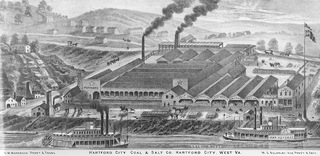 | Back to e-WV
| Back to e-WV
 The West Virginia Encyclopedia
The West Virginia Encyclopedia
 | Back to e-WV
| Back to e-WV
 The West Virginia Encyclopedia
The West Virginia Encyclopedia

From the colonial through early national periods, salt was a scarce domestic commodity that had to be imported. As settlers crossed the Allegheny Mountains, they found numerous salt licks, frequented by animals and native people, that naturally furnished small quantities of salt but not enough to meet the needs of an expanding settled society. As dependence on imported salt continued, the quest for commercial sources led to salt manufacturing at many licks. The first major enterprises in present West Virginia developed in 1797 under Elisha Brooks at the Great Buffalo Lick on the Kanawha River; in 1809 by John Haymond and Benjamin Wilson at Bulltown, Braxton County, on the Little Kanawha River; and around 1812 at John George Jackson’s works on the West Fork, near Clarksburg. Only the Kanawha salt field had the brine density to attain more than local importance.
At the Great Buffalo Lick at Kanawha Salines or present Malden, the Ruffner brothers built the first commercial furnace in 1808. Within two years, they and other entrepreneurs had constructed 16 furnaces. During the War of 1812, salt production quadrupled on 52 furnaces to reach one million bushels. This enormous growth of capacity caused Kanawha manufacturers to produce more salt than their markets could consume and as early as 1814–15 stimulated the creation of innovative legal arrangements to control excess production, prices, and markets. These agreements of combination, which took several forms, are the earliest known in American industrial and legal history.
Salt production in the Kanawha Valley was a relatively simple process. Shallow wells reached the subterranean brine water. Steam engines pumped the salty water from one or more wells to an elevated tank. From that point, water ran as needed into the evaporator, a giant flat pan heated by steam. As the brine evaporated, its salt crystallized. Workers skimmed the salt onto drain boards. After a period, the salt was lifted and wheeled to a storage house where it was packed into barrels for shipment.
Kanawha saltmakers pioneered in technological adaptation and inventiveness. They adapted coal as furnace fuel when wood became scarce; invented various well-drilling tools later adapted for petroleum drilling; early and extensively harnessed steam engines for pumping; and modified their furnace construction by the 1840s to the Kanawha grainer evaporative system, a low-pressure method of evaporating salt that survived over 100 years. They also molded the institution of slavery to meet industrial needs.
The importance of the Kanawha Salines manufacturers plummeted when another West Virginia brine field was discovered in the 1850s. Three Kanawha saltmakers developed the West Columbia salt field in Mason County on the Ohio River. Soon furnaces emerged at Hartford City, Mason City, and across the river around Pomeroy, Ohio. The Mason field had the advantage of being closer to markets. Also, Ohio River salt manufacturing fit well with the primary local economic activity of mining coal. The evaporators burned the ‘‘slack’’ or fine coal that otherwise would have been discarded. With minimal fuel costs and the adoption of business arrangements and productive technology from the Kanawha field, the Ohio River field eventually marginalized the Kanawha salt producers.
In the 1850s, the Kanawha salt field reached its peak and began to decline. The western movement of meat packing, the growth of a national railroad system, and other discoveries of salt contributed to the Kanawha industry’s demise and eventually adversely affected the Ohio River field as well. Salt production on one or two furnaces persisted in both fields until the mid-20th century. By that time Kanawha Valley salt making had been replaced by a booming chemical industry, which found other uses for the region’s brine waters and industrial know-how.
Written by John Edmund Stealey III
Stealey, John E. III. The Antebellum Kanawha Salt Business and Western Markets. Lexington: University Press of Kentucky, 1993.
Stealey, John E. III, ed. Kanawhan Prelude to Nineteenth-Century Monopoly in the United States: The Virginia Salt Combinations. Richmond: Virginia Historical Society, 2000.
Stealey, John E. III. Virginia's Mercantile-Manufacturing Frontier: Dickinson & Shrewsbury and the Great Kanawha Salt Industry. Virginia Magazine of History and Biography, (Oct. 1993).